If you’re new to contact center management or even a seasoned leader, putting (or keeping) your contact center plan in place can be overwhelming.
You have a vision of what you’d like to achieve. You can see what your team looks like at its best. Now, all you’ve got to do is implement that.
Sounds easy, right?
No, we didn’t think so, either.
Many moving parts can get in your way when tasked with the responsibility for your company’s entire customer experience. Lots of shiny objects tend to get attention.
Call volumes are always high. Your CSAT scores keep fluctuating. Your forecasts from last year are way off.
These are all elements that distract from genuine contact center management. They pull you into the doing and less of the managing.
This guide will introduce six key milestones that keep you on track and help you become a more proactive call center manager.
Our goal is for your contact center agents to thrive and for you to focus solely on management.
What Is Contact Center Management?
Contact center management ensures smooth running, high standards, and consistent customer experience. It involves the practices of people, process, and technology management.
Some contact center managers may prefer a hands-on approach. Others favor leading by introducing new methods, making decisions based on data, and reacting to trends inside and outside the contact center.
Like any management strategy, milestones and measurements guide contact center management. Using the right KPIs and tracking changes is crucial for the success of any contact center manager.
One modern example of how managers must adapt is upskilling call center agents to manage new digital channels. With this, managers must move from proven effective call center management to a genuine omnichannel approach.
What Makes a Good Contact Center Manager?
A great contact center manager can lead a team, implement processes, and adapt to changing processes and technologies.
The essential traits of a good contact center manager are:
- Patience with both customer escalations and new call center employees.
- Strategic vision to see the bigger picture and how to get there.
- Leadership to make decisions thoughtfully and deliberately to drive results
- Resource management to support team and business priorities.
- Flexibility to deviate from their original call center plans based on new data.
- Ownership to take responsibility and address when things go wrong.
120-Day Call Center Management Plan
At the start of their new plan, great contact center managers should focus on these milestones in their first four months.
These steps will help you avoid putting out fires and position yourself to create and execute a long-term strategy for the contact center.
These are the top priorities for incoming contact center leaders.
Days 1–14: Listen, learn, and gather data.
You can’t overlook the value of digging into the current call center operations, connecting with the team, and observing. A new call center manager brings fresh eyes to systemic problems and growth opportunities.
Objectives:
- Team satisfaction and effectiveness
- Senior leadership concerns and ambitions
- Gather business data (revenue, costs, etc.)
- Access to the workforce and call center systems
- Verbatim customer feedback surveys and ratings
- Validate customer journeys (aka, mystery shops)
Document your observations in 1:1 discussions as well as call recordings. Call recordings often reveal the norm for the contact center. But be sure to sample enough customer interactions before you go into “solution mode.”
Use these couple of weeks to connect with the call center agents, team leads, and business leadership to determine “the facts” to inform your call center strategy.
Days 15–30: Empower your team for inbound calls and digital channels
Phone calls have long been the bread and butter of successful call center operations. But, as we move to a more digital-first environment in our personal lives, we must cater to this in our businesses too.
The first step in your contact center management plan must be to empower your customers to reach you using their preferred method.
For example, if you run a customer support function for fitness watches and know your customer base is tech-savvy millennials, you can make some assumptions about how they want to contact you.
Popular customer contact methods
- Phone calls
- Website chatbots
- SMS text messaging
- WhatsApp messaging
- Social media public posts
- Email-based support tickets
- Live video and screensharing
- Social media direct messages
One survey suggests that 75% of millennials avoid phone calls, citing they’re too time-consuming. So, limiting yourself to only inbound calls is the wrong strategy.
Instead, ensure your organizational structure includes cross-skilling to deal with messaging apps like Twitter, WhatsApp, and Instagram.
While working out which channels to support, you must consider your staff’s roles in your contact center. You have specialized agents, call center supervisors, quality assurance teams, and many other functions to lead.
Think about creating an organizational chart to paint a clear picture of who handles what.
What Is the Organizational Structure of a Contact Center?
Most contact centers follow a templated organization chart. When you start creating yours, ask yourself the following:
- Do you need a specialized role for call monitoring and quality assurance?
- Should quality monitoring and quality assurance be the same person?
- Who handles workforce management and workforce optimization?
- Do you function as an outbound call center as well as inbound?
- Who tends to your brand’s social media interactions?
These are all essential questions to streamline your contact center management.
Traditional call center operations used to look like this:
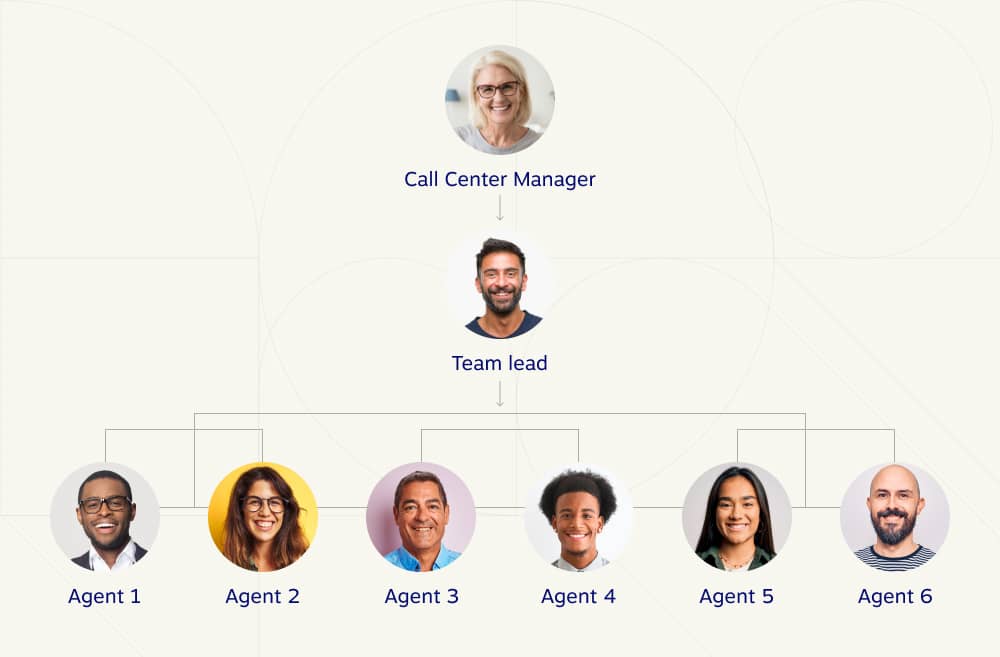
But a modern contact center org chart reflects unique roles and cross-skilled agents:
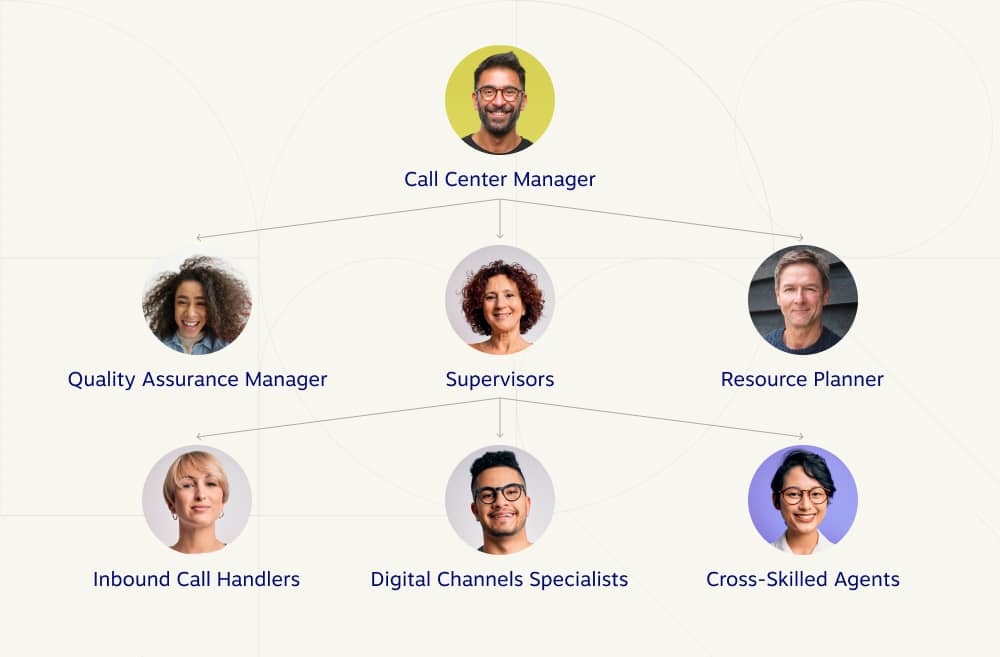
Make sure you include all your unique roles when building your chart. Refer to this regularly to keep it updated and spot any gaps as you progress.
Days 31–60: Start reporting on all customer interactions
Your contact center software likely already has some reports running in the background. This data serves as a benchmark and helps measure the impact of your call flow changes.
Typical call center metrics include:
- Call volume
- Peak hour traffic
- Call transfer rate
- Average wait time
- Longest hold time
- Average time in queue
These are traditionally displayed in basic historical reports or on live wallboards.
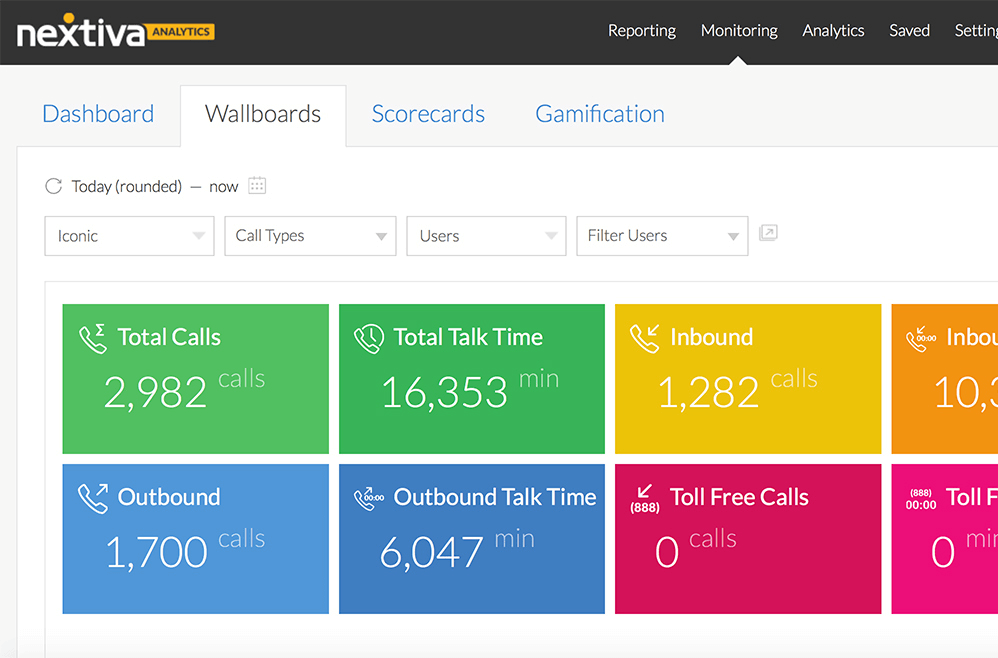
These metrics provide insight into the duration and quantity of calls. But they don’t provide context on the quality and problem-solving nature of the calls. They’re also limited to phone calls only.
In an omnichannel contact center, unified reporting across voice and digital channels will set your team up for success.
Implement further reporting to find out which channels get used most, where support tickets come from, where most sales come from, and so on.
It’s at this point that you start to see the extended benefits of contact center reporting too:
- Cost savings over separate, disjointed systems
- Know how your customers truly feel
- Improve agent productivity and retention
- Make data-driven business decisions
- Increase agility to react faster to trends on the fly
When you have information like this, you can prioritize KPIs and double down on the channels that matter the most.
Days 60–90: Set KPIs that focus on customer satisfaction
Put yourself in your customer’s shoes. What customer service experience do you expect when you call or send a message?
The service you expect to receive from others is the standard you must strive for.
How do you achieve this?
By setting the right KPIs, you get there. When someone calls your contact center, they don’t want to get passed around from agent to agent. They don’t want to hold for minutes and still not have a resolution.
Factors like these impact Net Promoter Score (NPS) and Customer Satisfaction. But more than a number on a scoresheet, they impact how your customers feel about you.
We’ve outlined the five most common KPIs, and often the most powerful. Use these to template what you’re measuring. Then tweak them to suit your business priorities.
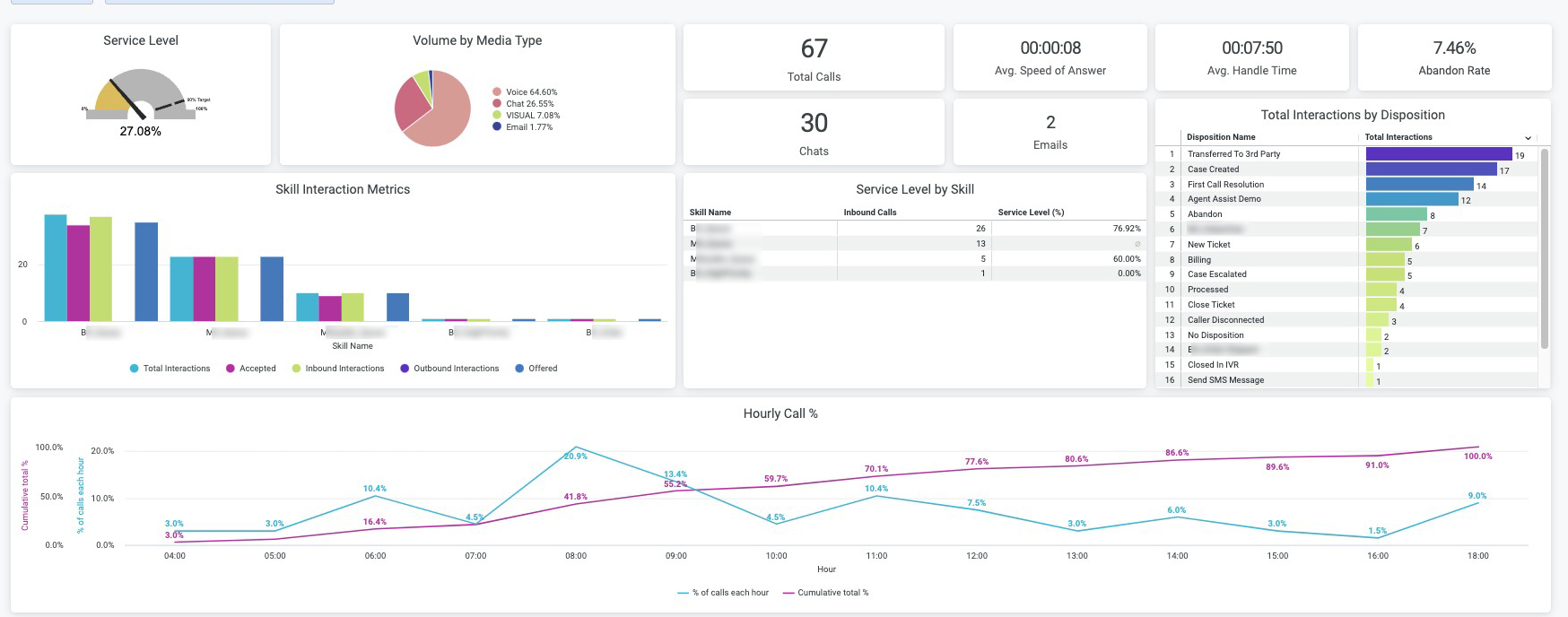
1. First call resolution (FCR)
The first call resolution, often shortened to FCR, is when you solve a customer’s problem the first time they contact your company.
By understanding the number (or percentage) of client problems solved in one call, your company can better measure the success of its documentation, materials, product design, and call center staff.
Of course, first-call resolution is just one part of the client experience.
For example, ‘first response’ measures when a client contacts your call center and when they get an answer from the call center staff. Tracking a number of key call center metrics ensures you have the best picture of your call center effectiveness as you work towards FCR.
2. Average handle time (AHT)
Average handle time, often shortened to AHT, is the amount of time it takes to help a customer in your call center. AHT is tracked in your call center software and is one of the most analyzed KPIs in the call center industry to measure efficiency. AHT includes the entire customer interaction — starting when the customer call begins to hold time and after-call work is completed.
AHT often relates to customer satisfaction and agent performance. In theory, the quicker you resolve a customer’s concern, the happier they will be. But, of course, there’s a significant human impact to factor in here too.
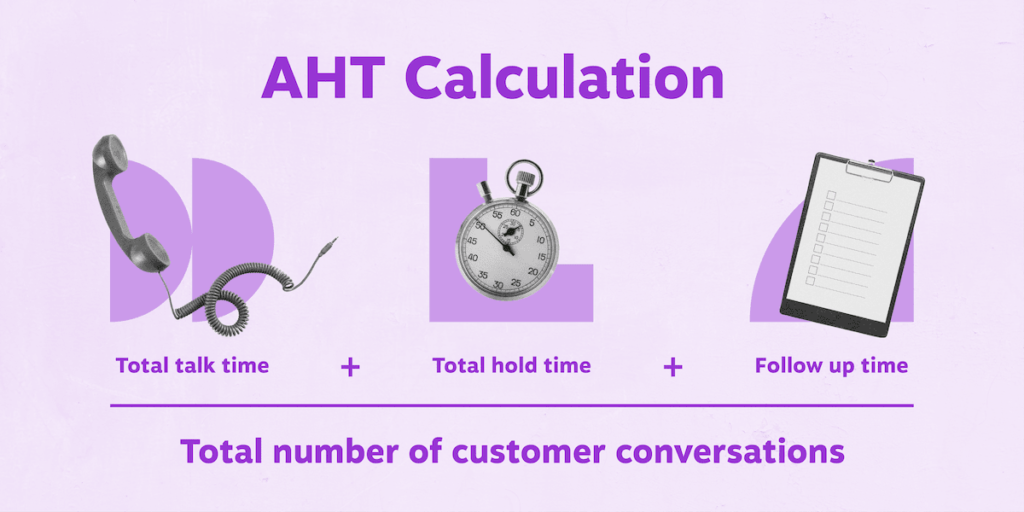
According to Gartner, AHT is one of five data points contact center leaders should track to improve the customer experience. The other leading metrics are speed of answer, first call resolution, customer satisfaction score, and Net Promoter Score®.
Your customers will be the happiest if you resolve their concerns on the first contact. A shorter handle time isn’t always better.
3. Average speed of answer
The average speed of answer, often shortened to ASA, is a call center metric that reports how long (on average) callers wait in a queue before an agent answers their call.
Reports use ASA to ensure the call center hits its service level agreements. It is like an estimated wait time but historical and accurate to the customer’s experiences.
High ASA stats, with low handle times, suggest you need more staff to handle your volume of calls.
Once you have an average answer speed, you can combine them with your call volume, develop accurate call forecasts, and evaluate the staffing you need.
4. Net Promoter Score® (NPS)
Net Promoter Score, often shortened to NPS, is a calculation used to determine how likely customers are to recommend your service. NPS ranges from -100 to +100.
Businesses use NPS to measure how well their company, product, or service performs over time.
A better or worse NPS than the previous period shows whether a business is more or less likely to receive a referral from a customer.
To calculate NPS, businesses use a survey approach to gain responses to a single question.
You can ask extra questions to find out why customers score you a certain way and what you could do to improve.
The core NPS question is:
How likely are you to recommend our company to a friend or colleague?
Respondents can score from 0 to 10.
0 means “not at all likely,” and 10 means “extremely likely.”
Taking the results from the main question, you total the number of responses, apply the NPS formula, and arrive at a final score.
5. Customer Satisfaction (CSAT)
Like NPS, CSAT is an excellent indicator of customer happiness. A good score means an upward boost in call center campaigns. Unlike NPS, however, there’s no standard way to calculate this KPI.
Typically, companies ask for customer feedback on whether an agent has adequately solved an issue. Survey responses are often classified into these groups: Very Satisfied, Satisfied, Not Satisfied, and Very Unsatisfied.
The final customer satisfaction score is the Very Satisfied and Satisfied ratio to the total survey respondents.
When you combine (or all) these call center metrics, you get a real-world (and real-time) view of agent performance.
Use this to learn where blockers are in the customer experience and where you can double down on training to improve staffing and service levels.
When it becomes the time to check in on your KPIs, make sure you follow these best practices so you don’t become consumed in data:
- Focus on the KPIs that matter most. Get clear on what drives revenue and retains customers.
- Customize reports to include what you need. Narrow your reporting into the metrics that matter. There’s such a thing as too much data.
- Share your reports. When agents know what’s measured, they can act on it better. Likewise, your leadership will be in the know.
- Respect agent feedback. People on the front line know why patterns emerge.
- Compare with industry benchmarks. Stay on top of industry expectations and monitor competitors for opportunities.
- Embrace experimentation. Don’t let that impatience halt business improvement. Pilot and validate ideas quickly so you don’t end up in analysis paralysis.
Days 90–120: Review agent performance and make changes
It might be a simple tweak to your call routing. You may need to change the order of the options on your interactive voice response (IVR).
It could be a shake-up of your workflow. It might be nothing. You won’t know until you review it.
Routine and proper scheduling of regular reviews of agent performance is imperative here. When you do this, cross-reference to see if individual performance matches your analytics’ data and trends.
Here’s the data type you can expect from an analytics package like Nextiva Analytics.
When you have both the numbers and the real-world happenings in front of you, it’s easy to see what changes you must make.
Ask yourself these questions:
- Do you have enough team members?
- Are your team members in the right places?
- Does the data show one thing, and agents report another?
You might be overstaffed in areas that could benefit from self-service and automation. Outsourcing basic questions like opening hours is the ideal role for chatbots and IVRs.
Some contact centers go a step further and use chatbots for more complex queries, too.
You might see recurring queries like pricing or specific customer needs that could get addressed at the point of sale or onboarding. When you find patterns and repetition, feed this back up the chain of command, so these questions get nipped in the bud early.
When you set better customer expectations, you always have better customer relationships. So you must provide rationale and data when making suggestions that affect the company. It’s easy for contact center managers to forget an entire company exists outside of this specialized business unit.
The same applies to employees. Part of contact center management is ensuring good employee engagement and a great employee experience.
If agent performance is dwindling, find the root cause of the problem. If call center performance was high before you introduced digital channels, specific agents should focus on inbound calls. Or they might need more training and further coaching.
If you ask a call center team to do something new without the appropriate time to learn new skills, you can’t expect them to perform from day one.
A thriving call center and a contact center are different beasts. Empower your team with the right tools, training, incentives, and goals.
If morale is low, think about introducing gamification or team-building activities. If you’ve got the right employees, you may need to match them with the right inspiration.
Beyond Day 120: Strive for continuous improvement
By now, you’ve got a core team of agents, supervisors, and specialists. Your processes are in order, and you’re managing customer expectations and providing a great customer experience.
You can’t stop here.
The bottom line is that you will always be making some changes to your contact center operations. Adopting this mantra is crucial so you don’t fall behind your competition.
Amber Dixon, the CEO of Elderly Guides, who operates a large contact center, says it’s hard to balance continuous improvement and day-to-day management:
At four months in, implementing continuous improvement while juggling daily tasks can be challenging. But it’s essential for maintaining high service levels and customer satisfaction. Here are a few strategies I’ve found effective …
Amber Dixon
- Prioritize: Not all tasks are equal. Determine which tasks are most crucial to your contact center’s success and focus your energy there.
- Empower your team: Train and trust your team to handle specific tasks. This autonomy frees up your time to focus on improvements and allows them to grow.
- Use data: Regularly review performance metrics and customer feedback to identify areas for improvement.
- Schedule dedicated time: Getting caught up in daily operations is easy. Ensure you set aside a specific time each week for strategizing and implementing improvements.
- Embrace technology: Use automation and AI to handle routine tasks, giving you more time to focus on strategic improvements.”
By four months, you’re no longer new, and the pressure is on to take this contact center to the heights you promised.
Helpful tactics to promote continuous improvement:
- Gather raw customer and agent feedback regularly
- Set triggers and alerts for dips and rises in your analytics
- Consult with senior management to understand company goals
- Conduct mystery shopper exercises to spot growth opportunities
This is often the time when contact center managers review the technology available.
Is your CRM doing everything you need it to? What functionality is lacking in your call center software? Is there a break in the process when customers prefer one channel to another?
The remedy here is often adopting an omnichannel approach. You can write all the processes in the world and analyze as much data as you like. But it’s all for nothing if you can’t implement those changes.
Omnichannel brings all your channels into the same solution and unifies the customer experience.
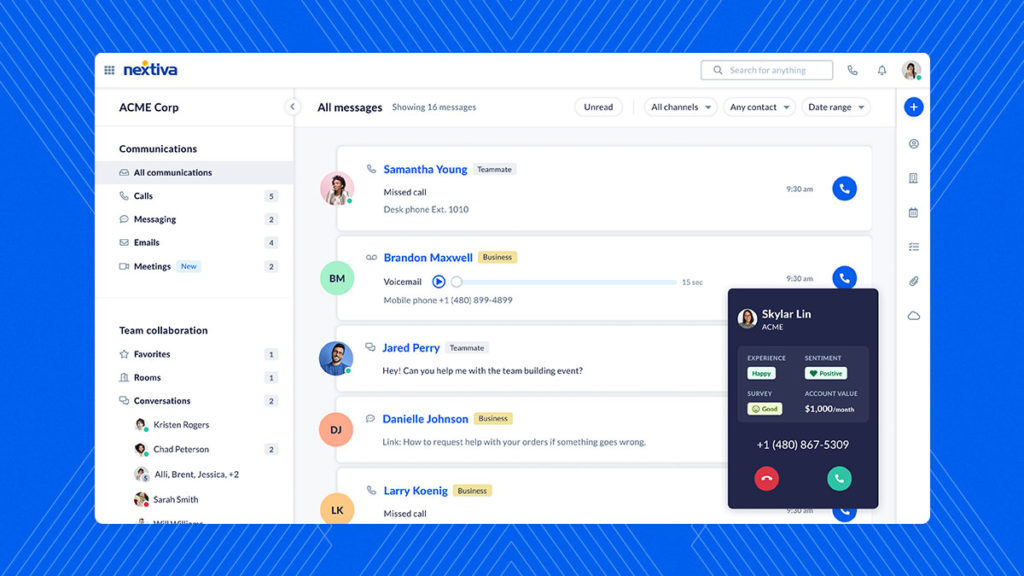
If Joe Smith calls you to follow up on their Twitter message that was a follow-up to their email, your agents would have access to the entire history. There’s no need to call another agent to see what’s happening. It’s all there in front of you. And everything gets tracked and reported on.
Modern, successful contact centers are omnichannel. Successful contact center managers must excel at multi-channel as well.
When you reach this milestone and explore a new contact center solution, check out how thousands of companies scale with Nextiva.



